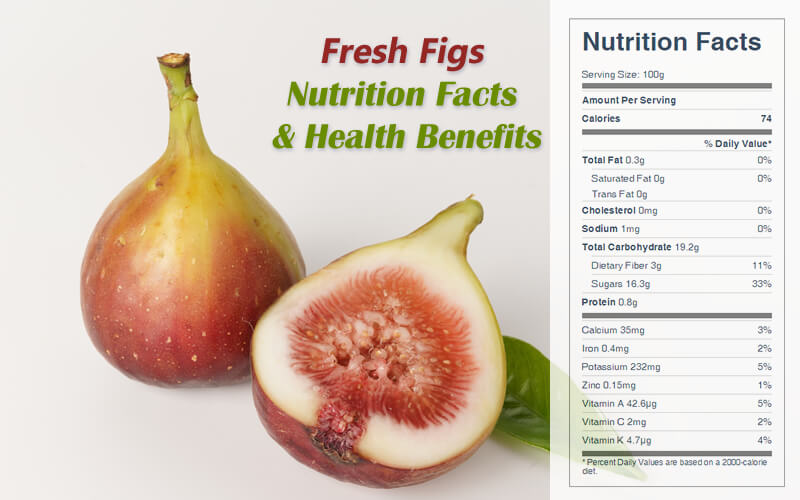Figs Nutrition Facts & Health Benefits
Figs have a centuries-old reputation as a sustaining and nourishing food. Figs are a good source of fiber and are high in protein. They are also among the best plant sources of calcium. Here are nutrition benefits of figs.
Raw figs contain roughly 79% water, 19% carbohydrates, 1% protein, and negligible fat. They are a good source of dietary fiber. A fig supplies 16 percent of the recommended daily intake for iron, 18 percent for magnesium, and 14 percent for potassium, which benefits your heart and other organs by keeping your blood pressure and hydration in balance. Fig leaves have been found to have some potential in controlling diabetes.

When dehydrated to 30% water, figs have a carbohydrate content of 64%, protein content of 3%, and fat content of 1%. Dried figs are a rich source of dietary fiber and the essential mineral manganese, while calcium, iron, magnesium, potassium, and vitamin K are present in moderate amounts.
Nutritional Composition of Raw Figs
One medium raw fig provides 37 calories, 9.6 g carbohydrate, 0.38 g protein, 0.15 g fat, 1.6 g dietary fiber, 71 IU vitamin A, 1 mg vitamin C, 3 mcg folic acid, 116 mg potassium, 18 mg calcium, 9 mg magnesium, 7 mg phosphorus, and 0.18 mg iron.
Nutritional Composition of Dried Figs
One dried fig provides 21 calories, 5.47 g carbohydrate, 0.28 g protein, 0.08 g fat, and 0.8 g dietary fiber.
Raw Figs Nutrition Facts Label
Health Benefits of Figs
Figs carry an excellent source of the phenolic compound proanthocyanidins—in an even greater capacity than red wine. The skin of the fig has even more antioxidant capacity, with higher polyphenols than the pulp. In addition, lycopene is the most abundant carotenoid, followed by lutein and alpha-carotene.
Figs are well known for their fig-derived polysaccharides: Ficus carica polysaccharides. FCPS possesses both antioxidant and anti-tumor properties. Many phenolic compounds play favorable antioxidant roles in human health because they can act as reducing agents, hydrogen donators, free radical scavengers, singlet oxygen quenchers, and so forth.
Figs are an excellent source of radical scavenging and antioxidant activity. The benefits vary depending on the variety of the fig, with mission figs (dark purple) having the highest polyphenol antioxidant capacity.
This fruit is antibacterial, antiparasitic, and restorative. In some old Mediterranean folk practices, the milky sap of the fig plant was used to soften calluses, remove warts, and deter parasites.
They have a high content of mucin, a soothing laxative. Since the late 1800s, syrup of figs combined with senna has been available as a laxative.
In either fresh or dried form, they are friendly to the digestive system. This is because they contain an enzyme called ficin that assists the digestive process by exerting a soothing action on the gut. Dried figs are a rich source of fiber, iron, potassium, and calcium, making them a useful food for people with high blood pressure. They have a special affinity for the stomach, spleen, and pancreas; help moisten the lungs and large intestines; and improve liver function, which can result in improved eyesight.
Weight for weight, figs contain more fiber than most other fruits or vegetables, so they’re great for your digestive system and your cholesterol levels.
They’re also very high in polyphenol antioxidants, which makes them a valuable food for cancer prevention. The instant energy they provide and their ability to prevent cramps make them good for athletes, too.
Figs also contain the compound benzaldehyde, which has been shown in Japanese studies to shrink tumors, as well as a sulfur compound called ficin, which helps reduce joint and tissue inflammation and is used to treat injuries.
Health Risk
Excessive consumption of figs may cause diarrhea.
As they are very sweet, figs should be eaten only sparingly by people desiring to lose weight. However, they are an excellent food for body builders and people wanting to gain weight.
Dried figs are considered the healthiest, but be sure to avoid those treated with the preservative potassium sorbate. Remember to brush your teeth after eating dried figs because their stickiness clings to the teeth and can contribute to tooth decay.
Like other plant species in the family Moraceae, contact with the milky sap of Ficus carica followed by exposure to ultraviolet light can cause phytophotodermatitis, a potentially serious skin inflammation.
Organic chemical compounds called furanocoumarins are known to cause phytophotodermatitis in humans. The common fig contains significant quantities of two furanocoumarins, psoralen and bergapten. They are found chiefly in the milky sap of the leaves. but not in the fruit.